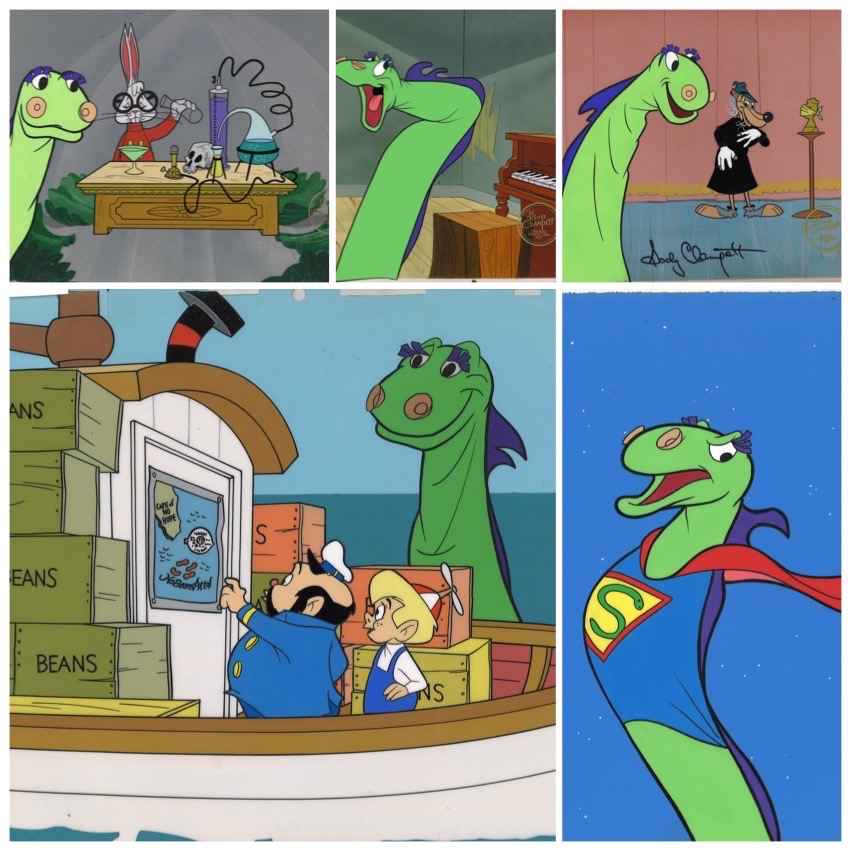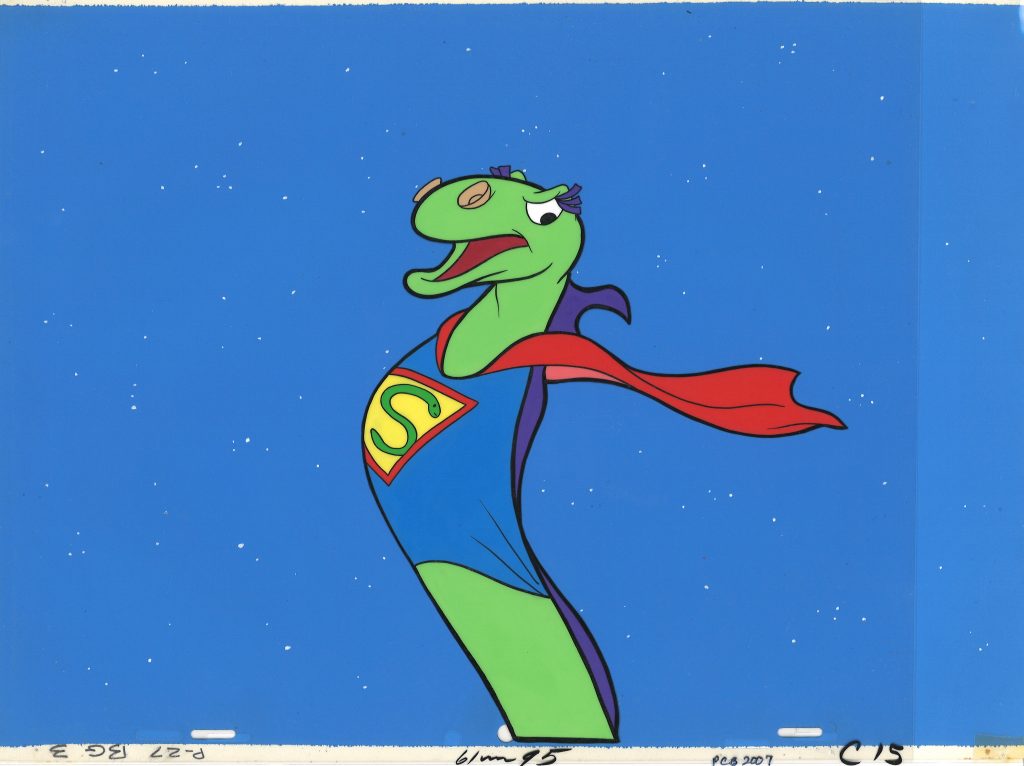For Father’s Day, an interview with Ruth Clampett about growing up with Bob Clampett, plus a vintage collection of Beany and Cecil art!
We have the incredible luck to have gotten just a few of the extremely rare Beany and Cecil original production cels from the original 1960s show. These Beany and Cecil originals come directly from the animator Bob Clampett’s estate, which is overseen by his children. With Father’s Day right around the corner, and knowing from my friend Ruth Clampett how wonderful Bob Clampett was to have as a dad, I thought it would be a wonderful time to ask Ruth a few questions about her experience, both about growing up the child of the renowned animator, and as someone who has kept the artistic legacy of her dad alive, and promoted the art of animation and film as the owner of Clampett Studios.
Born and raised in California, not far from Hollywood, Bob Clampett is well-known to many animation fans. He worked at Warner Brothers during the creation of some of the most classic Looney Tunes cartoons, directing 84 of them, some of which are deemed the best in their history. He designed some very iconic characters, including Porky Pig, Daffy Duck, and Tweety. Porky Pig is a character that was originally created by Friz Freleng, but fleshed out and made popular when Clampett pinned down his character in the late 30s. The animator was known for his wacky, outrageous animation, best expressed in his surreal classic which featured Porky Pig, 1938’s Porky in Wackyland. That animated short is a singular example in which artistry, animation, and humor blend perfectly. It is only because of the obsessive love of all things Disney at the time (remember this is right around the release of Snow White and the Seven Dwarfs) that it didn’t win an Oscar at the time. Actually, it wasn’t even nominated, but 4 Disney cartoons were, with Ferdinand the Bull the winner.
Beany and Cecil was created by Bob Clampett after he left Warner Brothers in 1946, some would say, at the height of his creativity as an artist. The cartoon was based on Clampett’s own earlier show, 1949’s Time for Beany, which featured puppets of a captain named Horatio (Or “Uncle Captain”), his nephew Beany Boy, as they travelled the high seas aboard the Leakin’ Lena. His best pal was a seasick serpent named Cecil. They had run-ins with a baddie named Dishonest John (or DJ for short). Watch a bit of it below:
After Time for Beany ended, Clampett revisited the characters by developing the Beany and Cecil cartoon show, which premiered in 1962.
That series was considered the first fully creator-driven television series, and announced itself as “a Bob Clampett Cartoon”. He and his team created 26 shows, which included 78 cartoons, and were repeated on Saturday mornings for the next five years.
One notable, and valuable aspect of the show was in the opening, where Cecil sings “A Bob Clampett cartoon!” It was a way that Bob Clampett got recognition for his work and creation. Working for other studios, the directors were not recognized, with the studio head getting prime billing. As someone who sells art by animation and film artists, many of whom remain relatively unknown, it is a pleasure to see.
All these years later, there are still fans who remember watching and loving the Beany and Cecil characters have a strong cult following. This show paved the way for lots of other animation, as did all of Bob Clampett cartoons.
Ruth Clampett, Bob’s daughter, owns the art business that represents most of the official Looney Tunes animation, all the art from Hanna Barbera, as well as art from Harry Potter, and all animation from DC Comics.
I asked her if she had any Beany and Cecil art she could ask her family to offer through ArtInsights, and I was thrilled that she prevailed upon them to give me some rare original Beany and Cecil art from the 1962 cartoon.

I asked Ruth a few questions about her experience growing up with these iconic characters, what the art itself means to her and her family, and what made Bob Clampett a great dad:
What are a few really great memories of Beany and Cecil you remember that stays with you from when you were growing up?
Growing up a Clampett meant that I was growing up inside a cartoon…there was always a sense of wonder and magic. There was very little delineation of my dad’s work life and home life. Dad had a great sense of humor and would always come up with stories or ways to entertain us. We would hang out at my parent’s studio in Hollywood where his office was full of art and toys, and then come home to a house where Beany and Cecil toys and our art abound. At school our friends would sing to us, “A Bob Clampett Cartoo-o-o-on!” It was an animated life for sure.
When did you discover these cels, which are from your father’s estate? Can you talk about your perspective on the pieces themselves?
My dad kept everything he could on projects that he had loved in his career, so my brother, sister and I were always aware of Dad’s archives and understood how meaningful it was to him. The Beany and Cecil art is an important part of that archive. We naturally have respected and preserved it as best we could. ..those cels are sixty years old!
Meanwhile my brother, Rob, has overseen art and photos being loaned for books, museum exhibits and such. It has always been our dream to have the collection in a museum and many images in a book about his career. We won’t stop until that dream is realized.
As for the Beany and Cecil cels, I do think they capture that era where characters weren’t overdone, but had engaging and unique personalities. How can you look at a Cecil cel and not smile along with him?
What makes Beany and Cecil so special as a cartoon?
I think what was special about Beany and Cecil was their friendship and how they always looked out for each other as two “best pals” would. Cecil was big-hearted, but also gullible and often Beany would be the one to look out for Cecil. But if Beany was ever in trouble, Cecil would charge ahead and save his little pal. Other important aspects were that despite the limited TV animation of that time, the shows were very story driven. They were always on an adventure to unusual places where they would meet every kind of creature and character. There was always excitement and lots of laughs in every episode. We were also entertained with spoofs on popular movie studios or Disneyland (as in the episode “Beanyland.” And exposed to hip characters like Go Man VanGogh, the Wildman of Wildsville, who was ahead of his time.
Dad was always at the forefront of animation and character basedentertainment, whether puppets or cartoons. He worked on the first Merrie Melodies cartoon at 17, and at the age of 15 helped his aunt, Charlotte Clark, design the first Mickey Mouse Doll. He was truly destined to have career in animation. Years later when he learned about the advent and possibilities of television at the World’s Fair he knew he wanted to be part of that new frontier in entertainment.
His puppet show, Time for Beany was a sensation and won three Emmys. The immediacy of puppetry on television was very exciting for a storyteller like my Dad. So later when the idea came about to do limited animation for television, Dad was inspired to take his popular puppet characters, Beany and Cecil, and immerse them in the animated world.
Did you dad ever talk about the characters or reference them to you, in terms of art or as an animator? How and when did you connect to your dad as an artist and animator, and realize he was important to animation history?
Dad was always coming up with new ideas and would often share them with us. When MTV first came on the air with all music videos we talked about how he would do a video with a band and have animated characters as part of the video. I loved that idea.
From one artist to another I learned from him to look for inspiration everywhere. Dad was passionate about music, movies, and happenings in the news. We grew up around art books, museums and shows. He and my mom always encouraged us to follow our passion and be willing to try new things. They gave us a lot of freedom, both creatively and making our own decisions and I will always be thankful for having such an inspiring environment and encouraging parents. They always made me believe that I could achieve anything I truly set my mind and heart to.
What would you want people to know about your dad? What made him special?
I know many animation fans must wonder based on Dad’s Looney Tunes cartoons that this guy must have been pretty wild with how energized and wacky his cartoons could get. What they don’t know is that he did have a great sense of humor and loved to laugh, he also had a big heart and was very kind. I never heard him speak bad of anyone, even people who had treated him badly, and as an adult I realize how unusual that is. He didn’t care about money or fancy things. Instead nothing made him happier to hang out with a group of young animators and fans, find out about what they were working on or inspired about, and then sharing stories they asked to hear.
This has all been wonderful. Thanks, Ruth. Can we finish this interview with you telling us one great memory you have of your dad that stays with you?
I think when I was about nine my Dad had the idea that it would be fun to have a family puppet show. He and my Mom put a series of numbers together and then he directed us using the Time for Beany puppets (mainly obscure secondary characters) for the show. We had a lot of fun and ended up performing at a number of events. I credit that experience also for making me never be afraid to get up and speak in front of a crowd. That comes in handy every year when I present the Humanitarian award in his name at the San Diego Comic Convention!
You can read a bunch more about the making of Beany and Cecil in a story by a storyboard artist who worked on the show, Robert Story, by going HERE. Here is a video where Sody Clampett, Bob’s wife and Ruth’s mom, talks about Bob’s career:
It’s too bad the dvd of the complete 1962 Beany and Cecil cartoon show are so incredibly hard to come by, but it’s no surprise. Even some Oscar-winning Bugs cartoons cost a fortune, if you can find them.
Lastly, check out a bit of the panel I did at San Diego Comic-Con featuring Ruth Clampett and Linda Jones, called “Looney Tunes Legacy”. Ruth talks about her dad:
As part of my blogging about animation and our animation art collection during the pandemic, I have been ending with a COVID Comfort Cartoon. This week, I’m using the Beany and Cecil cartoon Harecules and the Golden Fleecing, because I thought it might amuse the many, many parents who are having to home-school very smart kids.


